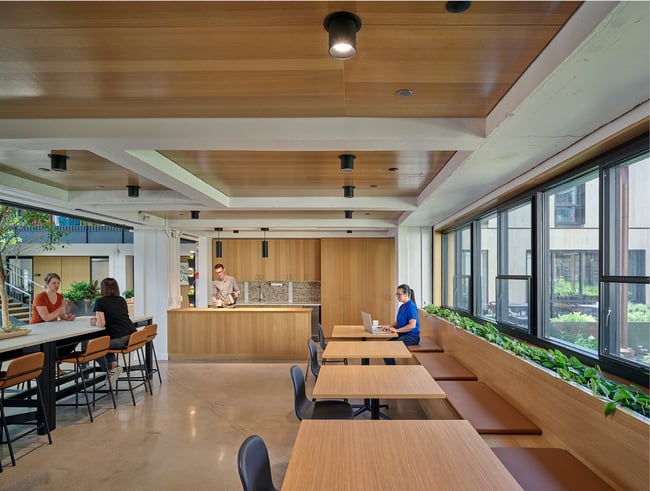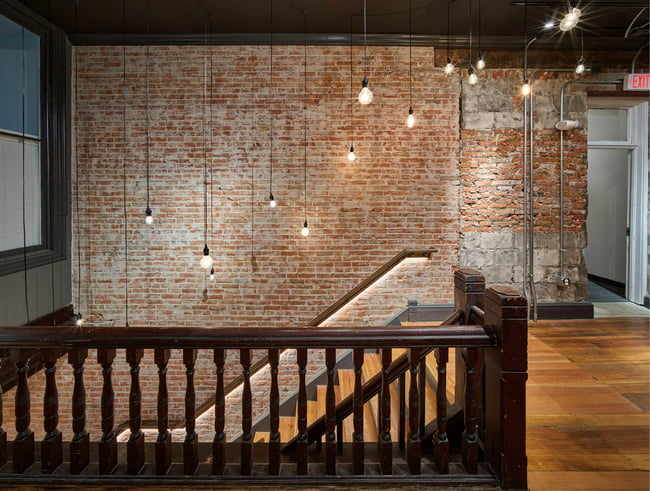Growing Priorities in Sustainable Design

Sustainable design is always innovating, with priorities shifting to address the growing climate crisis. In recent years, new practices have emerged that improve occupant well-being, minimize waste, and increase resiliency in the face of climate change.
Sustainable design is becoming more holistic, expanding its purview beyond energy efficiency. In our studios, we’ve kept up with these priorities by focusing on material health, embodied carbon reduction, and regenerative design practices.
This article will explain these practices and how they are driving the industry, giving you a better understanding of sustainable design, its scope, and its future.
4 Sustainable Design Priorities
1. Material Health and Transparency
Building materials and their impact on human health have become a growing priority for architects and interior designers. Many common chemicals found in building materials—including bisphenols, phthalates, and formaldehyde—have been linked to short-term and chronic health conditions, and the industry is working to avoid them.
Frameworks like the AIA’s Architecture and Design Materials Pledge and the Living Future Red List help designers make more thoughtful selections. In the coming years, we may see an industry response to other chemicals as researchers better understand their effects.
Along with human health impacts, designers are paying more attention to materials’ embodied carbon levels. Embodied carbon refers to the greenhouse gas emissions associated with a material or system’s life cycle, including its manufacturing, transportation, maintenance, and disposal.
Tools like the Tally Life Cycle Assessment app can help designers measure these emissions at each stage of the design process. These tools can also evaluate other environmental impacts, including a material’s potential to harm water and soil. With new technologies, designers can integrate sustainable design thinking into all levels of a project—from planning a structural system to choosing interior finishes.
2. Occupant Health and Wellness
Beyond materials, designers are focusing on human health and wellness more broadly. The Covid-19 pandemic brought to light once-underrecognized problems with the built environment, and designers are shifting their focus to air quality, daylight, and ventilation.
There is also a growing recognition of buildings’ impact on mental health. Designers are considering neurodiversity—how different people think, work, and process emotions. In the workplace, neurodiverse design manifests in a wider variety of spaces, including areas for collaborative work, quiet spaces for concentration, and wellness rooms for respite. In the coming years, other market sectors may adopt similar practices.
At the same time, biophilic design is becoming increasingly important in all markets. Practices like increasing daylight and views, creating connections to the outdoors, and using natural materials are gaining prominence.

Biophilic design practices are gaining prominence across all building types.
Although these practices have been around for years, the public has not always recognized their importance. Mindsets are shifting away from maximizing square footage to creating more pleasant experiences for occupants.
3. Regenerative Design
Historically, sustainable design has focused on improving energy efficiency and “doing less harm.” Now, the profession is shifting toward regenerative design.
Largely spearheaded by the Living Building Challenge (LBC), regenerative design seeks to make a positive impact on the environment and community.
Regenerative practices can include producing all energy on-site, gathering potable and non-potable water through rainfall, and recharging groundwater. In short, a regenerative building helps communities become more resilient to climate change.
4. Adaptive Reuse and Urban Density
As embodied carbon reduction becomes a priority, renovations and adaptive reuse projects are gaining popularity. The most sustainable building is one that already exists. By reusing building stock, we can reduce waste and the carbon emissions associated with manufacturing and transporting new materials.

Reusing existing building stock helps reduce embodied carbon emissions.
Public acceptance of adaptive reuse has grown since the pandemic. With a large amount of underutilized building stock, cities are looking to address housing shortages by renovating office buildings.
Such projects can help mitigate urban sprawl and improve density. With more pedestrian-oriented cities, we can become less reliant on fossil fuel-emitting vehicles. The goal is to better utilize existing developments and preserve vulnerable sites like green fields, farmlands, and wildlife habitats.
Learn More About Sustainable Design
While energy efficiency remains a top priority for design professionals, new priorities are emerging. To address the climate crisis, we must develop a more rigorous framework that considers a building’s total environmental impact.
These growing priorities are helping reduce embodied carbon emissions and improve resiliency within communities—all while keeping people and their well-being top of mind.
In our experience, the best approach to sustainable design is using a building certification system. Programs like LEED and LBC provide a framework for evaluating design decisions and third-party proof that your building is operating as intended. Learn more by reading about the most popular certification systems.